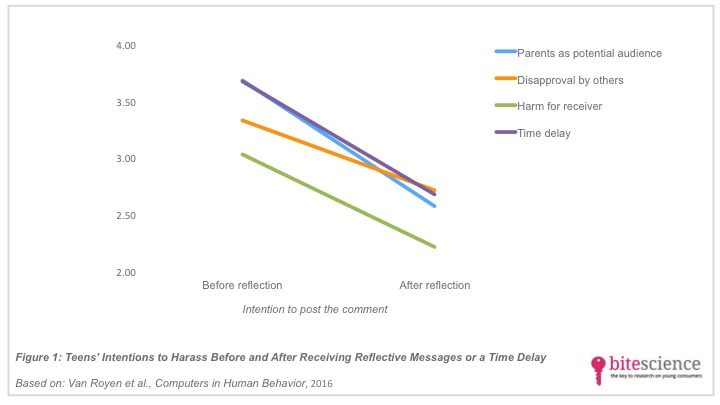
Think Twice! Making Teens Rethink Harmful Comments Reduces Online Harassment
Worldwide, a large number of teens are bullied, insulted, or stalked via the Internet. These victims are at risk of depression, anxiety, and loneliness, which emphasizes the need to discourage this so-called online harassment. A viable way to achieve this is by prompting teens to reflect on the harmful comments they intend to post, a study in Computers in Human Behavior shows.
Take aways
- Teens’ intentions to post harassing comments on social media can be reduced in four ways:
-
- By presenting them a message saying that others would disapprove of the harmful comment;
- By presenting them a message warning that parents could read their comment;
- By presenting them a message that points out the potential harm of the comment for the receiver;
- By inserting a time delay before they can post a message.
- For social media developers it is useful to know that reflective messages (and posing a time delay) can help stop online harassers by counteracting impulsivity and increasing their self-control.
Study information
The question?
Can automatically generated messages or a mere time delay prompting teens to reflect on their harmful posts reduce online harassment?
Who?
321 high school students (mean age: 15.6 years old; 60% girls)
Where?
Flanders, Belgium
How?
High school students were asked to participate through their schools. Teens who agreed to participate were presented with a scenario involving online harassment via a computer at school. In this hypothetical scenario, a girl named Merel posts an update on social media that her friend Hanna has stolen her boyfriend. Teens were instructed to imagine that Merel was a friend of theirs. Subsequently, teens’ intentions to harass were measured by asking them whether they would post harassing comments aimed at Hanna, such as ‘whore’ or ‘slut’. Only the teens who indicated that they would do so were randomly presented with one of three reflective messages: one saying that parents could read their post, another pointing out disapproval of the comment by others, and a final one warning about the potential harm for the receiver. It was also possible that a teen was not presented with a message but only with a time delay. Immediately after receiving the message or time delay, teens’ intentions to harass were assessed again. Moreover, teens answered questions about their level of empathy (e.g., sharing and understanding others’ emotions) and behavioral inhibition (e.g., engaging in impulsive behaviors).
Facts and findings
- Almost half of the teens (49%) said they had the intention to post the comment ‘slut’ and were consequently presented with one of the three messages or a time delay.
- Teens who were presented with either one of the three messages showed a decrease in their intention to post a harmful comment (see Figure 1).
- Also the teens who did not receive a message but were only presented with a time delay indicated decreased harmful intentions (see Figure 1).
- Showing the message about parents as a potential audience resulted in the largest decrease in teens’ intentions to harass.
- For teens with high behavioral inhibition the message about parents lead to a larger decrease in the intention to harass than for teens with low inhibition. The authors suggested that this is because teens with high inhibition are more sensitive to potential punishment.
- Critical note: Teens were presented with a hypothetical scenario but could not actually act on their intentions (i.e., post the comment or not), which might have limited the realness of the study. Future studies should test the effect of reflective messages in a more naturalistic setting.
